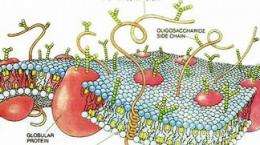A closer look at cells

Many substances and nutrients are exchanged across the cell membrane. EPFL scientists have developed a method to observe these exchanges, by taking a highly accurate count of the number of proteins found there. Their research has just been published in the Journal Plos One.
Proteins on the cell surface play an essential role in the survival of the cell. They govern the exchanges between the interior and the exterior. Now, EPFL scientists have found a way to observe them in action. They have developed a method based on fluorescence microscopy that gives them a very precise image of the composition of the membrane and the exchanges taking place there. Their results are published July 26 in an article in Plos One, an online journal specializing in science and medicine, as well as in a June 12, 2011 letter to the journal Nature Methods.
“It is important to study the membrane because it is an exchange platform between the cell and its environment,” explains Aleksandra Radenovic, Professor in the Laboratory of Nanoscale Biology and one of the study’s authors.
Permeable to some molecules but closed off to others, the membrane controls the movement of substances and nutrients between the interior and the exterior of the cell. The proteins in the membrane play critical roles in the cell, particularly in energy transfer, gene expression and nutrient transport.
Using the method they developed, the scientists can now count these proteins very accurately. In so doing, they obtain valuable information on their interactions and their evolution. It allows them to know more about how a cell reacts to the administration of a drug or exposure to an external agent (such as a pollutant), and why a given cell behaves differently from another cell. “Eventually, this technique could thus help us develop more effective drugs,” Radenovic says.
Capturing light
This research is based on very high resolution data provided by a special fluorescence microscopy technique called Photo Activated Localization Microscopy (PALM). Developed just under five years ago, this technology has revolutionized molecular imaging. It works on the principle of capturing light that is emitted – either naturally or upon combination with a fluorescent substance (fluorochrome) - by certain bodies at the nanometer scale.
Once the biological sample is placed under the microscope, the scientist “illuminates” the molecules with a series of successive flashes. The assemblage of images then forms a very high resolution image, which allows the scientists to pinpoint the location of proteins at extremely small scales.
The Laboratory of Nanoscale Biology is continuing its investigations, in order to refine the use of this technology and the quantification of elements present in the membrane in the most reliable manner possible. In particular, they are working on a “photoactivatable” protein called mEos2. The voyage into the infinitely small universe of the cell has just begun…
More information: Quantitative Photo Activated Loalization Microscopy : unraveling the effects of photoblinking», by Aleksandra Radenovic, et al. Plos One doi:10.1371/journal.pone.0022678
"Identification of clustering artifacts in photoactivated localization microscopy", Nature Methods doi:10.1038/nmeth.1627
Provided by Ecole Polytechnique Federale de Lausanne


















